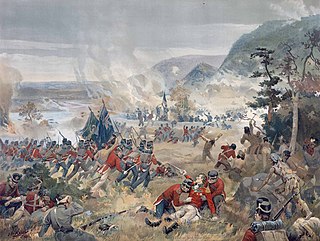
The Battle of Queenston Heights was the first major battle in the War of 1812. Resulting in a British victory, it took place on 13 October 1812 near Queenston, Upper Canada.
The Battle of York was a War of 1812 battle fought in York, Upper Canada on April 27, 1813. An American force, supported by a naval flotilla, landed on the western lakeshore and captured the provincial capital after defeating an outnumbered force of regulars, militia and Ojibwe natives under the command of Major General Roger Hale Sheaffe, the Lieutenant Governor of Upper Canada.

The Battle of Lundy's Lane, also known as the Battle of Niagara, was fought on 25 July 1814, during the War of 1812, between an invading American army and a British and Canadian army near present-day Niagara Falls, Ontario. It was one of the bloodiest battles of the war, and one of the deadliest battles fought in Canada, with approximately 1,720 casualties including 258 killed.
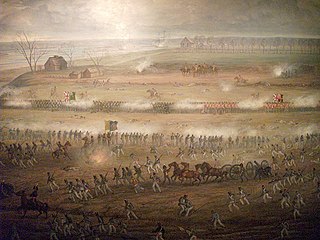
The Battle of Crysler's Farm, also known as the Battle of Crysler's Field, was fought on 11 November 1813, during the War of 1812. A British and Canadian force won a victory over a US force which greatly outnumbered them. The US defeat prompted them to abandon the St. Lawrence Campaign, their major strategic effort in the autumn of 1813.
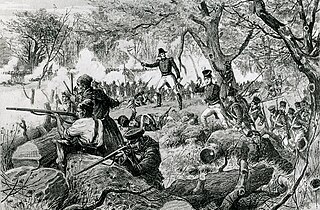
The Battle of the Chateauguay was an engagement of the War of 1812. On 26 October 1813, a combined British and Canadian force consisting of 1,530 regulars, volunteers, militia and Mohawk warriors from Lower Canada, commanded by Charles de Salaberry, repelled an American force of about 2,600 regulars which was attempting to invade Lower Canada and ultimately attack Montreal.

General Sir Gordon Drummond, GCB was a Canadian-born British Army officer and the first official to command the military and the civil government of Canada. As Lieutenant Governor of Upper Canada, Drummond distinguished himself on the Niagara front in the War of 1812 and later became Governor-General and Administrator of Canada.

The Battle of Chippawa, also known as the Battle of Chippewa, was a victory for the United States Army in the War of 1812, during its invasion on July 5, 1814, of the British Empire's colony of Upper Canada along the Niagara River. This battle and the subsequent Battle of Lundy's Lane demonstrated that trained American troops could hold their own against British regulars. The battlefield is preserved as a National Historic Site of Canada.

The Second Battle of Sacket's Harbor, or simply the Battle of Sacket's Harbor, took place on 29 May 1813, during the War of 1812. A British force was transported across Lake Ontario and attempted to capture the town, which was the principal dockyard and base for the American naval squadron on the lake. Twelve warships were built here. The British were repulsed by American regulars, militia, marines and sailors.
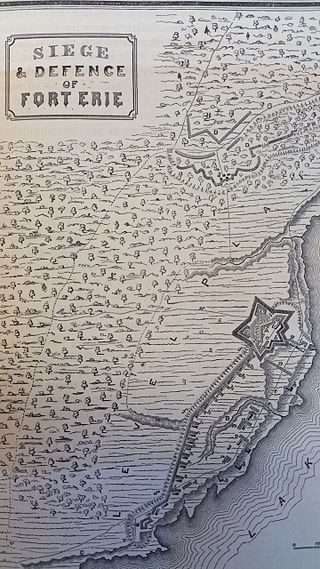
The Capture of Fort Erie by American forces in 1814 was a battle in the War of 1812 between the United Kingdom and the United States. The British garrison was outnumbered but surrendered prematurely, in the view of British commanders.

The siege of Fort Erie, also known as the Battle of Erie, from 4 August to 21 September 1814, was one of the last engagements of the War of 1812, between British and American forces. It took place during the Niagara campaign, and the Americans successfully defended Fort Erie against a British army. During the siege, the British suffered high casualties in a failed storming attempt; they also suffered casualties from sickness and exposure in their rough encampments. Unaware that the British were about to abandon the siege, the American garrison launched a sortie to destroy the British siege batteries, during which both sides again suffered high losses.

The Battle of Fort George was fought during the War of 1812, in which the Americans defeated a British force and captured Fort George in Upper Canada. The troops of the United States Army and vessels of the United States Navy cooperated in a very successful amphibious assault, although most of the opposing British force escaped encirclement.
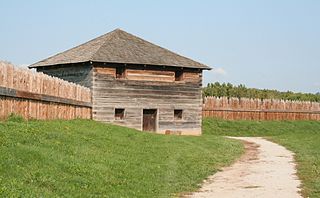
The siege of Fort Meigs took place in late April to early May 1813 during the War of 1812 in northwestern Ohio, present-day Perrysburg. A small British Army unit with support from Indians attempted to capture the recently constructed fort to forestall an American offensive against Detroit, and its Fort Detroit in the Great Lakes region which the British from the north in Canada had captured the previous year. An American sortie and relief attempt failed with heavy casualties, but the British failed to capture the fort and were forced to raise the siege.

The Battle of Ogdensburg was a battle of the War of 1812. The British gained a victory over the Americans and captured the village of Ogdensburg, New York. Although small in scale, it removed the American threat to British supply lines for the remainder of the war.

The Battle of Mackinac Island was a British victory in the War of 1812. Before the war, Fort Mackinac had been an important American trading post in the straits between Lake Michigan and Lake Huron. It was important for its influence and control over the Native American tribes in the area, which was sometimes referred to in historical documents as "Michilimackinac".

General Sir Phineas Riall, KCH was the British general who succeeded John Vincent as commanding officer of the Niagara Peninsula in Upper Canada during the War of 1812. In 1816, he was appointed Governor of Grenada.

The Battle of Buffalo took place during the War of 1812 on December 30, 1813, in the State of New York, near the Niagara River. The British forces drove off the American defenders and destroyed many buildings and ships. The operation was retaliation for American troops burning the Canadian village of Newark.
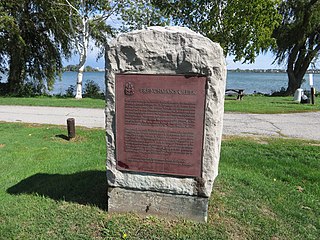
The Battle of Frenchman's Creek took place during the War of 1812 between Great Britain and the United States in the early hours of November 28, 1812, in the Crown Colony of Upper Canada, near the Niagara River. The operation was conceived as a raid to prepare the ground for a larger American invasion. The Americans succeeded in crossing the Niagara and landing at both of their points of attack. They achieved one of their two objectives before withdrawing but the invasion was subsequently called off, rendering useless what had been accomplished. The engagement was named, "the Battle of Frenchman's Creek" by the Canadians, after the location of some of the severest fighting. To contemporary Americans, it was known as, "the Affair opposite Black Rock".
The Canadian Volunteers was a unit composed of pro-United States citizens or inhabitants of Upper Canada which fought for the United States of America during the Anglo-American War of 1812.
The Battle of Lewiston saw Major General Phineas Riall lead a combined British and Native force against the American town of Lewiston. They defeated the Americans in the area and then looted and burnt the town.
On January 8, 1814 a contingent of 70 Americans led by General John Swift attacked a group of British soldiers gathering wood a half-mile from Fort Niagara.



















